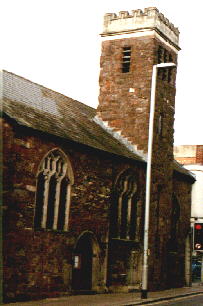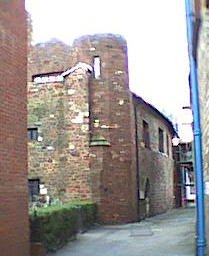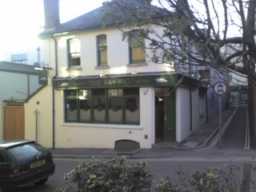
|

|
| EX4 | The top of the street |
| The Walkabout | The Mint and Methodist Church. |
| The Mint | Next to the Mint, St Nicholas Priory. |
| The Fat Pig | Smythen, Paul, and King St, Butchers Row |
| Vivo | Tuckers Hall, Picture House & Batholomew Terrace. |
| The Queen Victoria | The Tudor House. |
| Use the text links for more information! |
No sidebar menus?, Click Here and re-select |
| Saint
Next door is St Olaves church which was probably founded as a house chapel for
Gythia, Countess Of Wessex, mother of King Harold I, whose husband to the Earl Godwin of Wessex,
died in 1053. Gythia then moved to Exeter.
Traditionally it is thought that the priest of St Olaves helped Countess
Gythia to escape to the Continent in 1068 when William The Conqueror
began his siege of Exeter. The Church is dedicated to King Olaf, King and patron saint
of Norway. Among others he fought Canute,
King of Denmark and England.
Canute was related by marriage to Countess Gythia, so it is somewhat strange
that the church should be dedicated to St. Olaf. Countess Gythia must have
hated Canute, but then anyone who tries to stop the tide coming in without
the use of the Thames Barrage deserves all they get.
Next up is the Walkabout (opened late 1997) a
short walk down the hill from St Olave's Church. Its on the left. This is an Australian themed bar resident in many
a UK city.
The bar opened in the mid nineties and does a roaring trade especially at the weekends. During the 2002
World Cup, people were queueing at 08.30 to get in for England v Argentina match. Many were turned away.
Apparently there were about 800 people inside.
|
 |
|
Mint
Just over the road is the Mint Methodist Church opened in 1970. This is a smart looking building but replaced one even better. The original church was built in 1813 in Georgian style, but by 1965 it had become unsafe and was demolished. The site was sold to the Musgrove Alley Chapel methodists in 1812 who then built their church. One drawback however was the proximity to the Oatsheaf Inn which once stood in front of the church which is set back from the road. The owners of the Inn used to deliberately block an entrance from the Mint Lane with rubbish and carts. This gate can still be seen if you care to walk a short distance down Mint Lane. Anyhow a devout methodist, Thomas Rowe put paid to this in 1878 when he bought the lease of the Oatsheaf Inn. After he'd expired so did the lease but his will allowed the church to inherit the pub and demolish it. |
As for the Mint itself, there were effectively three periods during which coins were struck in Exeter.
All were struck in different locations. The mint here in Friernhay produced coins for Charles I during
the civil war (1644 and 1645). Evidence suggests that striking took place in a large private residence.
When parliamentarian forces took Exeter in 1646, Vyvyan (who had set up the mint for the king) was
procecuted for having seized such a house so it therfore seems likely that this house was the mint. The
exact location though remains unknown. For more information on the other Exeter Mints, click the link.
The Mint (pub) is just over the road by Mint Lane. Neck your pint and head over. This place got a major facelift in mid 2004. The bar area is now on one level having formerly had more stairs than the Eiffel Tower. The bogs are amongst the most difficult to get to in the world. |
|
|
|
| Monk
Mint Lane runs alongside the pub and leads to St Nicholas Priory, a
monastery with its' own church. It was built by monks from Battle Abbey,
Sussex in 1089 who were sent by William the Conqueror to serve St Olaves Church
in 1068.
The original priory was extended in C12th and
C13th but alot of damage was done by Henry VIII during his dissolution
of the monasteries. About 25% of the original structure is still in place.
From 1791, Roman Catholics used the remains to hold masses until the
Sacred Heart
was built in South Street in 1884.
1791 was an important year for English Catholics. They were given freedom to worship for the
first time since the reign of Elizabeth I.
The priory was bought by Exeter
Corporation in 1913 for £850.00 and restored. It is open to the public
and admission is free.
The undercroft, cloister entrance
(both from the C11th), first floor bed chamber and Great Hall (both from
C15th) with an arch-braced timber roof are worth seeing.
|

|
No.21 The Mint, makes up the North Range of the C11th Monastery, the Priory comprising the West Range. The building
can be veiwed in all its glory from the yard of St Olaves Hotel who part-lease
the accomodation within the building which was originally the Benedictine Monks' refectory, a vast high-ceilinged hall built in 1070.
A recent £850k restoration has given a new life to the building.
In the C14th, the number of monks at the monastery declined and the hallway was converted into a main hall for Prior's duties such as rent collecting and interviewing tennants. In the C15th there was a major restoration and indeed re-build. The roof was constructed in the 1450's The C16th saw the reformation and the monastery was closed in 1536. In 1570, the refectory became a private residence and with time, floors, partitions, walls and floors were added severely weakening the structure. There was however a profusion of styles and patchworks of history all of which are caught up in this building which by the 1990's was derelict, unsafe and worthless. |

Over the road is Cody, formerly occupied by Bobby's.
|
|
| Smiths and Butchers
When you've finished your pint head over the road and through the arcade
which will take you to Smythen Street. This street was first recorded in
the mid C12th during the reign of Henry II
and was where all the Smiths lived, probably making armour and trappings for horses. At this time the
main thoroughfare through the city will have run along this street down
Stepcote Hill to the West Gate.
Butchers Row was the name given to the top end of Smythen Street from C15th onwards until C19th.
A row of butcher's stalls populated the side of the street with many of the beasts being slaughtered
in the open and put up for sale. Piles of dung and offal were sold alongside
the meats on the stalls.
There was also a fish market nearby. The locals had to fart for fresh air. This is an area of
the City once known as the West Quarter
and was infamous for the closeness of living conditions, the
industry of it's occupants, their squalor and disease. Life expectancy was
not good, this was Exeter's poor area and it extended down to the river
where most of the industry took place.
It has now been re-developed. Just
down Smythen Street on the corner of Paul Street is the Fat
Pig. Nip in here for a pint, the pub has recently (End Feb 2008) been
renovated with many of it's original features restored. It was known as the Coachmakers Arms
until before this renovation but had undergone many changes in it's long history.
This current building however looks to only date from the early C20th, my guess would be a re-build around 1928 when most
of the WestQuarter buildings were demolished and some re-built.
From 1913 the pub was a City Brewery house, being sold to the Pub management, Henry Austin Harding in 1965. The pub was
modernised in true 1960's fashion during this time with the "boxing in" of many of the buildings original (early C20th)
features such as fireplaces and ornate ceilings plus the re-positioning of the entrance further down Smythen Street.
|

|
John Street was named after the Church of St John which used to stand
at the Fore Street end. Before 1863, it's Chancel bowed over John Street
much like St Stephen's Bow in the High Street.
The archway gave access to Butchers Row for the carts delivering goods to be sold at the markets. The Church clock had two minute hands, one showing Exeter time and the other Railway time or London time. There was a difference of about twenty minutes. The church dated from the C11th but was made redundant by the
relocation of people from the West Quarter and was demolished in 1938.
Once you've finished head on down Smythen Street to King Street.
|
|
A zinc bath cost 2d if you had the money whereas an iron tub was alot
cheaper. Men and boys bathed here on Fridays and Saturdays in preparation
for the weekend drinking sessions. The women used it in between.
Tucker
Head back towards Fore Street and turn left down the street. On the right is Tuckers Hall which is again freely open to the public. This is a fairly substantial building with jacobean panelling and a Victorian facade. It was built in 1471 and became the Guildhall of Weavers, Fullers and Shearmen in 1490. A single storey chapel was divided horizontally in the C16th. Exeter at the time was important in the production of woollen goods with many being employed along the Exe. Many of the people employed as such resided in the West Quarter, and worked in Shilhay and Exe Island among the mills and factories. |